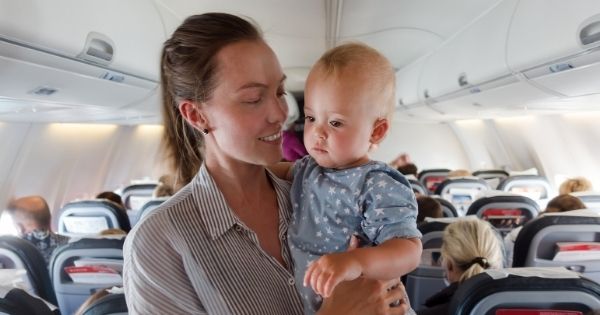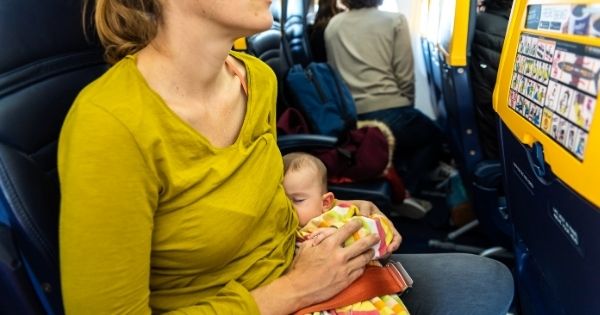If you’re a breastfeeding mom, you know the benefits. Breast milk is nature’s perfect food nutritionally, and nursing is more convenient, cheaper, and has health benefits for you as well such as a lower risk of breast and ovarian cancer. But if you’re planning your first trip away from home, you may be wondering how to manage. Here are some tips to help breastfeed successfully on the go.
Know Your Rights
Breastfeeding in public is not against the law anywhere in the world. Even in Saudi Arabia where women aren’t allowed to expose any part of their bodies, breastfeeding is the exception. However breastfeeding in public may not be socially acceptable in some places, namely Russia and Ukraine. If you’ll be traveling abroad, it’s a good idea to include “nursing in public” while researching the local culture and norms.
Flight attendants have been known to ask passengers to cover up while breastfeeding. Checking with the airline ahead of time can give you more confidence. Of course, it’s always a good idea to show modesty. Dressing for exposing the breast is easy. Wear a tank top with spaghetti straps over a nursing bra and add a cardigan. Or you can simply carry along a nursing cover.
Even in the United States, you may encounter someone who is offended by a nursing mom. If you are harassed, simply state your rights and carry on. Call the police or security if you feel physically threatened.
Breastfeeding on Road Trips
If you aren’t traveling alone, consider driving at night while the baby is sleeping. Most babies and toddlers take at least one long daytime nap, and that’s also a good time to take off. Otherwise, before hitting the road, feed your baby one last time at home. Also, research places to stop along the way before leaving such as restaurants, parks, and rest areas.
According to the Centers for Disease and Control and Prevention, breastmilk can be kept safely at room temperature for six to eight hours. For long road trips, your need to store pre-pumped milk in bottles. Make sure the bottles can seal tightly to prevent leakage and contamination and place them in a cooler packed with ice. The milk will stay cool for up to 24 hours if the cooler is insulated and packed with ice packs. To warm the milk up for feeding time, make sure you have a portable bottle warmer. They come in several varieties including ones with an adapter that plugs into the car’s lighter.

Breastfeeding on Planes
If you’re traveling by plane, you’ll find breastfeeding more convenient than by car since the baby can sit on your lap. And nursing at take-off and landing can help equalize the pressure on your baby’s ears. Remember that an airplane’s dry, recirculating air can be dehydrating. Drink plenty of water and stay hydrated for the days before your trip. (As a nursing mother, you should do that anyway).
If you want to bring along pre-pumped milk, the TSA allows mothers, with or without a child to bring breast milk aboard. It falls in the category of liquid medication. Be aware that any amount of liquid over 3.4 ounces may be subject to inspection or screened by X-ray. Inform the agent if you don’t want your breast milk opened or X-rayed so they can take other measures to clear the milk.
If possible, choose an aisle seat. It will be easier to get in and out with a baby. A travel neck pillow will make breastfeeding more comfortable. Place it between your arm and the armrest. If you are seated next to a stranger, it’s a good idea to let them know you plan to nurse, and then be discreet with your cover-up. But keep in mind if you don’t prefer to cover up, you don’t have to. Notify the flight attendant if any confrontation arises. You can report harassment incidents by calling 1-855-NIP FREE.
At the Hotel and Out and About
Make sure your accommodation has at least a mini-fridge so you can keep any pumped breast milk cool. Many hotels offer babysitting services, so you’ll need a supply should you decide to go out without the baby to enjoy the nightlife. If you plan on drinking, prepare an extra feeding to have until the alcohol clears from your system, usually around four hours. If your accommodation doesn’t have a kitchen or kitchenette you’ll need a bottle warmer.
Most babies will nurse just about anywhere. Theme parks, restaurants, and hotel lobbies should pose no problem for breastfeeding. And for walking tours and museums, a baby sling-type carrier that fits on the front is a lifesaver. When it comes to cover-ups, remember that it’s your personal choice, but do consider the local customs. Some places are more accepting of breastfeeding than others.
Keep in mind that jet lag also affects babies. A jolt to your tiny one’s internal clock can make her fussy. The closeness of breastfeeding can help comfort her. If you’ve traveled to a different time zone, nurse on the same schedule that you did back home then gradually adjust to the new time.
Also keep in mind that this might be a good base for your baby’s daytime nap, however there are lots of other options if you need to let them nap on the go.

Traveling While Breastfeeding Without Your Baby
You may need to travel for a family emergency, or perhaps you just want to take a quick getaway trip without your baby. You can! Determine a feeding pattern and make sure you have an ample supply of expressed milk by using your breast pump. Pump enough to last while you’re away plus a little extra. This will give you and your care provider peace of mind. Breast milk can be kept in the freezer for up to four days and frozen for six months. Look for baby bottles with nipples designed for breastfeeding babies to eliminate nipple confusion. Try the bottle out before leaving.
Once you’re away, you’ll need to maintain your milk supply. Pumping will keep your breasts from becoming engorged and prevent the cessation of lactating. It’s best to take along a manual breast pump. You won’t need to worry about finding an electrical outlet at the airport or on the plane.
Try to stick to your baby’s feeding schedule while pumping. Even just a few minutes can maintain your milk supply. Nursing is one thing, and pumping a breast is another. You’ll need a quiet, private place. While traveling on a plane, the airline may provide you with a clean quiet place. Just ask!
Many women report that hearing another baby cry can bring on lactation. No worries. Breast pads designed for leakage will keep your shirt or blouse.

About The Author
Anna was born to travel the world having studied languages all her life. Although she has traveled the world, she now calls Switzerland home and spends her time writing about her experiences on Expert World Travel. You can follow her on Facebook, Twitter, and Pinterest.

 Kaboutjie SA Mommy Blogs by Lynne Huysamen
Kaboutjie SA Mommy Blogs by Lynne Huysamen





thanks so much for this info!
This article is spot on.
This article is amazing. Thank you
Really such useful advise. I give all these tips to my neighbours daughter who are pregnant and young. Thank you so much. Appreciated. Keep it coming.
My little boy is 12 weeks – old and this was an insightful article, it will help a lot with my breastfeeding journey
This was extremely helpful thankful
This was extremely helpful thank you
Great article. Very helpful. Thank you
So helpful thank you so much!!! 💚💜💛💙❤️
I am expecting with my second and I did not breastfeed with my first as I was not producing enough milk. I am so looking forward to breastfeeding
This blog is very informative🤞
Great stuff
Everything a breastfeeding mommy wants to know..
I’m a proud breastfeeding mom😃😃